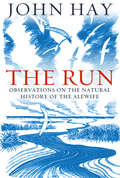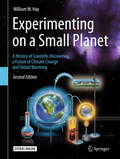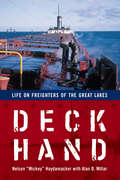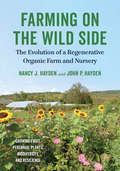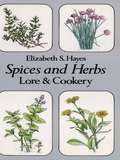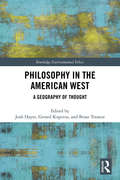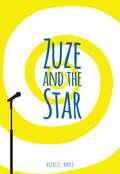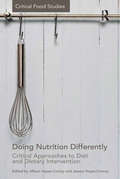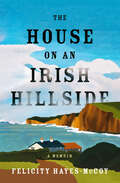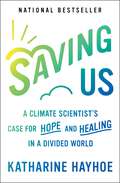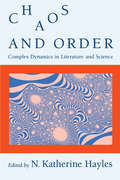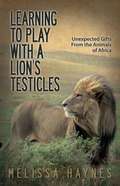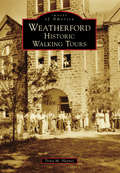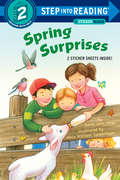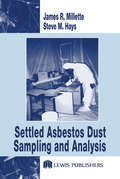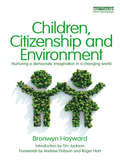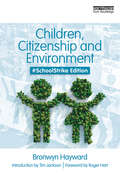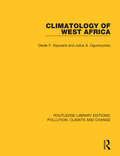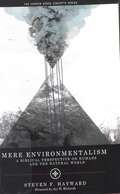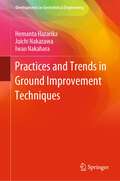- Table View
- List View
The Run: Observations on the Natural History of the Alewife (Concord Library)
by John HayThe Run, first published in 1959 and a classic in nature-writing, describes the life-history of the alewife, a small type of herring that spawns in freshwater, travels to the ocean when a fingerling, and then returns to its freshwater birthplace in impressive swarms as an adult. Author John Hay (1915-2011) was a naturalist who spent much of his life on Cape Cod and was the co-founder and long-time president of the Cape Cod Museum of Natural History. Illustrated with pen and ink drawings and two maps.
Experimenting on a Small Planet
by William W. HayThis book is a thorough introduction to climate science and global change. The author is a geologist who has spent much of his life investigating the climate of Earth from a time when it was warm and dinosaurs roamed the land, to today's changing climate. Bill Hay takes you on a journey to understand how the climate system works. He explores how humans are unintentionally conducting a grand uncontrolled experiment which is leading to unanticipated changes. We follow the twisting path of seemingly unrelated discoveries in physics, chemistry, biology, geology, and even mathematics to learn how they led to our present knowledge of how our planet works. He explains why the weather is becoming increasingly chaotic as our planet warms at a rate far faster than at any time in its geologic past. He speculates on possible future outcomes, and suggests that nature itself may make some unexpected course corrections. Although the book is written for the layman with little knowledge of science or mathematics, it includes information from many diverse fields to provide even those actively working in the field of climatology with a broader view of this developing drama. Experimenting on a Small Planet is a must read for anyone having more than a casual interest in global warming and climate change - one of the most important and challenging issues of our time.
Deckhand: Life on Freighters of the Great Lakes
by Nelson Mickey HaydamackerLong before popular television shows such as Dirty Jobs and The Deadliest Catch, everyday men and women---the unsung heroes of the job world---toiled in important but mostly anonymous jobs. One of those jobs was deckhand on the ore boats. With numerous photographs and engaging stories, Deckhand offers an insider's view of both the mundane and the intriguing duties performed by deckhands on these gritty cargo vessels. Boisterous port saloons, monster ice jams, near drownings, and the daily drudgery of soogeying---cleaning dirt and grime off the ships---are just a few of the experiences Mickey Haydamacker had as a young deckhand working on freighters of the Great Lakes in the early 1960s. Haydamacker sailed five Interlake Steamship Company boats, from the modern Elton Hoyt 2nd to the ancient coal-powered Colonel James Pickands with its backbreaking tarp-covered hatches. Deckhand will appeal to shipping buffs and to anyone interested in Great Lakes shipping and maritime history as it chronicles the adventures of living on the lakes from the seldom-seen view of a deckhand.
Farming on the Wild Side: The Evolution of a Regenerative Organic Farm and Nursery
by Nancy J. Hayden John P. HaydenOne farm’s decades-long journey into regenerative agriculture—and how these methods enhance biodiversity, pollinators, and soil health Northern Vermont’s Nancy and John Hayden have spent the last 25 years transforming their draft horse–powered, organic vegetable and livestock operation into an agroecological, regenerative, biodiverse, organic fruit farm, fruit nursery, and pollinator sanctuary. In Farming on the Wild Side they explain the philosophical and scientific principles that influenced them as they phased out sheep and potatoes and embraced apples, pears, stone fruits, and a wide variety of uncommon berry crops; turned much of their property into a semi-wild state; and adapted their marketing and sales strategies to the new century. As the Haydens pursued their goals of enhancing biodiversity and regenerating their land, they incorporated agroforestry and permaculture principles into perennial fruit polycultures, a pollinator sanctuary, repurposed greenhouses for growing fruit, hügelkultur, and ecological “pest” management. Beyond the practical techniques and tips, this book also inspires readers to develop greater ecological literacy and respect for the mysteries of the global ecosystem. Farming on the Wild Side tells a story about new ways to manage small farms and homesteads, about nurturing land, about ecology, about economics, and about things that we can all do to heal both the land and ourselves.
La miel (¡Arriba la Lectura! Level K #83)
by Julie HaydonNIMAC-sourced textbook <p><p> ¿Sabes cómo hacen la miel las abejas? ¿Sabes qué tarea cumple cada tipo de abeja? ¡Lee y lo sabrás!
Spices and Herbs: Lore and Cookery
by Elizabeth S. HayesThis introductory guide to the romance of spices and herbs offers historical, geographical, literary, and culinary details. More than 85 familiar and exotic plants are illustrated, examined for legendary lore, and current use. The book also includes 73 recipes, a spice chart, and tips for gardening, drying, freezing, and more. "An adventurous exploration." -- Richmond Times-Dispatch.
Philosophy in the American West: A Geography of Thought (Routledge Environmental Ethics)
by Josh Hayes Gerard Kuperus Brian TreanorPhilosophy in the American West explores the physical, ecological, cultural, and narrative environments associated with the western United States, reflecting on the relationship between people and the places that sustain them. The American West has long been recognized as having significance. From Crèvecoeur’s early observations in Letters from an American Farmer (1782), to Thoreau’s reflections in Walden (1854), to twentieth-century thoughts on the legacy of a vanishing frontier, "the West" has played a pivotal role in the American narrative and in the American sense of self. But while the nature of "westernness" has been touched on by historians, sociologists, and, especially, novelists and poets, this collection represents the first attempt to think philosophically about the nature of "the West" and its influence on us. The contributors take up thinkers that have been associated with Continental Philosophy and pair them with writers, poets, and artists of "the West". And while this collection seeks to loosen the cords that tie philosophy to Europe, the traditions of "continental" philosophy—phenomenology, hermeneutics, deconstruction, and others—offer deep resources for thinking through the particularity of place. This book will be of great interest to students and scholars of Philosophy, as well as those working in Ecocriticism and the Environmental Humanities more broadly.
Moving Words About a Flower
by K. C. HayesWords tumble, leap, and fly in this clever shape poem about a resilient dandelion.The inspiring story of a dandelion that survives against all odds, ingeniously told through shape poems (also called "concrete poems") full of visual surprises. When it rains, letters fall from the sky; and when seeds scatter, words FLY!Each playful page will have readers looking twice. The back of the book includes more information about the life cycle of the humble, incredible dandelion.
Zuze And The Star (Red Rhino)
by Vicki C. HayesZuze is a fan of the great Rufus Roth, a superstar musician from the past. And she is thrilled when her music class gets to go on a time traveling field trip. The class will visit five rock concerts. They will listen to two songs at each concert. Then they will return to class to write their reports. Zuze hopes Rufus Roth will sing her favorite song, “Susie Girl.” Will she be disappointed?
Doing Nutrition Differently: Critical Approaches to Diet and Dietary Intervention (Critical Food Studies)
by Allison Hayes-Conroy Jessica Hayes-Conroy'Hegemonic nutrition' is produced and proliferated by a wide variety of social institutions such as mainstream nutrition science, clinical nutrition as well as those less classically linked such as life science/agro-food companies, the media, family, education, religion and the law. The collective result is an approach to and practice of nutrition that alleges not only one single, clear-cut and consented-upon set of rules for 'healthy eating,' but also tacit criteria for determining individual fault, usually some combination of lack of education, motivation, and unwillingness to comply. Offering a collection of critical, interdisciplinary replies and responses to the matter of 'hegemonic nutrition' this book presents contributions from a wide variety of perspectives; nutrition professionals and lay people, academics and activists, adults and youth, indigenous, Chicana/o, Latina/o, Environmentalist, Feminist and more. The critical commentary collectively asks for a different, more attentive, and more holistic practice of nutrition. Most importantly, this volume demonstrates how this 'new' nutrition is actually already being performed in small ways across the American continent. In doing so, the volume empowers diverse knowledges, histories, and practices of nutrition that have been marginalized, re-casts the objectives of dietary intervention, and most broadly, attempts to revolutionize the way that nutrition is done.
The House on an Irish Hillside: A Memoir
by Felicity Hayes-McCoy&“A lovely writer, far superior to the average memoirist. . . . A curious mind, a perceptive observer with an artist&’s eye, a seeker of truth and beauty.&” —Irish IndependentFrom the moment I crossed the mountain, I fell in love with the place, which was more beautiful than any I&’d ever seen. And with a way of looking at life that was deeper, richer and wiser than any I&’d known before. . . . From the first day I came here I always knew I&’d come back. Sometimes we have to go back to our beginnings to become the person we want to be. More than a decade ago, USA Today–bestselling author Felicity Hayes-McCoy left the hectic pace of London and returned to her home country of Ireland to forge a new life in a remarkable house on the stunning Dingle peninsula. Gorgeously written, this is a life-affirming tale of rediscovering lost values and remembering the things that matter most. &“Wise, funny and touching, this book is a portrait of friendships, customs and folklore of Ireland; but what stays with you is harder to catch, like smoke or running water. It is the taste of something we all once knew, ever-present if only you look for it.&” ―Joanna Lumley, actress and author of Absolutely: A Memoir &“The book glowed . . . when I finished reading, I felt a sense of well-being, wonder and delight.&” —Alice Taylor, bestselling author of To School Through the FieldsPraise for Felicity Hayes-McCoy &“A pitch-perfect delight.&” —Marian Keyes, international bestselling author of Grown Ups on The Transatlantic Book Club &“The spot-on descriptions of Ireland&’s country roads and expansive sky all but leap off the page. . . . Maeve Binchy and Patrick Taylor fans will find much to enjoy.&” —Booklist on The Library at the Edge of the World &“Sunshine on the page.&” —Cathy Kelly, bestselling author of Between Sisters on The Month of Borrowed Dreams
Saving Us: A Climate Scientist's Case for Hope and Healing in a Divided World
by Katharine Hayhoe&“An optimistic view on why collective action is still possible—and how it can be realized.&” —The New York Times &“A must-read if we&’re serious about enacting positive change from the ground up, in communities, and through human connections and human emotions.&” —Margaret Atwood, Twitter United Nations Champion of the Earth, climate scientist, and evangelical Christian Katharine Hayhoe changes the debate on how we can save our future.Called &“one of the nation's most effective communicators on climate change&” by The New York Times, Katharine Hayhoe knows how to navigate all sides of the conversation on our changing planet. A Canadian climate scientist living in Texas, she negotiates distrust of data, indifference to imminent threats, and resistance to proposed solutions with ease. Over the past fifteen years Hayhoe has found that the most important thing we can do to address climate change is talk about it—and she wants to teach you how. In Saving Us, Hayhoe argues that when it comes to changing hearts and minds, facts are only one part of the equation. We need to find shared values in order to connect our unique identities to collective action. This is not another doomsday narrative about a planet on fire. It is a multilayered look at science, faith, and human psychology, from an icon in her field—recently named chief scientist at The Nature Conservancy. Drawing on interdisciplinary research and personal stories, Hayhoe shows that small conversations can have astonishing results. Saving Us leaves us with the tools to open a dialogue with your loved ones about how we all can play a role in pushing forward for change.
Chaos and Order: Complex Dynamics in Literature and Science (New Practices Of Inquiry Ser.)
by N. Katherine HaylesThe scientific discovery that chaotic systems embody deep structures of order is one of such wide-ranging implications that it has attracted attention across a spectrum of disciplines, including the humanities. In this volume, fourteen theorists explore the significance for literary and cultural studies of the new paradigm of chaotics, forging connections between contemporary literature and the science of chaos. They examine how changing ideas of order and disorder enable new readings of scientific and literary texts, from Newton's Principia to Ruskin's autobiography, from Victorian serial fiction to Borges's short stories. N. Katherine Hayles traces shifts in meaning that chaos has undergone within the Western tradition, suggesting that the science of chaos articulates categories that cannot be assimilated into the traditional dichotomy of order and disorder. She and her contributors take the relation between order and disorder as a theme and develop its implications for understanding texts, metaphors, metafiction, audience response, and the process of interpretation itself. Their innovative and diverse work opens the interdisciplinary field of chaotics to literary inquiry.
Learning to Play With a Lion's Testicles
by Melissa HaynesThe cheeky title of Melissa Haynes's story of adventure in Africa, Learning to Play with a Lion's Testicles, earned the book some big publicity on NBC-TV/Late Night with Jimmy Fallon on September 4,2013 where it topped the show's list of "Titles Not to Read" for September 2013. Melissa's book was also a big smash on the March 11, 2014 Ellen Show, where Ellen and guest Ricky Gervais highlighted the book throughout the entire hour. Playing with a lion's testicles: An African saying that means to take foolhardy chances.Melissa, an exhausted executive from the city seeks meaning and purpose from her work, and volunteers for a Big Five conservation project in South Africa. Her boss, an over-zealous ranger, nicknamed the Drill Sergeant, has no patience for city folk, especially if they're women, and tries to send her packing on day one. But Melissa stands her ground with grit and determination, however shaky it may be.Conflict soon sets the pace with a cast filled with predatory cats, violent elephants, and an on-going battle of wits with the Drill Sergeant. Even Mother Nature pounds the reserve with the worst storm in a century. But the most enduring and profound conflict is the internal battle going on within Melissa, as she tries to come to terms with the guilt surrounding her mother's death. When death grips the game reserve, it is the very animals Melissa has come to save that end up saving her.For the reader who has ever dreamed of going to Africa or knows the pain of loss and guilt, LEARNING TO PLAY WITH A LION'S TESTICLES will fill your soul.
Weatherford: Historic Walking Tours
by Trina M. HaynesWeatherford was settled in the 1850s, when the pioneers and Indians came for its rich soil and water sources. The mark of fame for Weatherford is the Goodnight-Loving Trail, which was driven by two cattle drivers, Charles Goodnight and Oliver Loving. Charles Goodnight, who was killed in an Indian attack, is buried in Weatherford, and a historical marker is placed at his grave in the historic Greenwood Cemetery. Cotton and watermelon were the popular industries, and watermelon festivals still bring crowds to the Courthouse Square. Over 150 images highlight Weatherford's historic town square buildings, the courthouse, homes, and cemeteries. Take a journey back into the 1800s with this photographic walking tour from the Courthouse Square to far and away. These images will bring back to life how Weatherford was built, how it survived, and the pioneers who kept its rich history alive.
Spring Surprises (Step into Reading)
by Anna Jane Hays Hala Swearingen WittwerSay goodbye to winter and celebrate all the fun and exciting surprises springtime offers—like flying kites, making mud pies, watching new baby animals take their first steps, and dancing among the raindrops! This joyful ode to all things spring is filled with easy-to-decode rhymed text and bright, inviting art. Spring Surprises includes two sheets of stickers.
Settled Asbestos Dust Sampling and Analysis
by Steve M. Hays James R. MilletteSettled Asbestos Dust Sampling and Analysis compiles the most significant data on asbestos in settled dust. This ready reference presents an analysis of settled dusts and surface particles of all sizes for asbestosthat is useful for qualitative and quantitative assessment and helps to determine the source of fibers. The main scope of this reference includes sample collection, sample analyses, and interpretation of settled dust data, as well as the use of such data for purposes including asbestos abatement projects and in-place management programs. Sections on lead and other particulates are also included.
Children, Citizenship and Environment: Nurturing a Democratic Imagination in a Changing World
by Bronwyn HaywardChildren growing up today are confronted by four difficult and intersecting challenges: dangerous environmental change, weakening democracies, growing social inequality, and a global economy marked by unprecedented youth unemployment and unsustainable resource extraction. Yet on streets everywhere, there is also a strong, youthful energy for change. This book sets out an inspiring new agenda for citizenship and environmental education which reflects the responsibility and opportunities facing educators, researchers, parents and community groups to support young citizens as they learn to 'make a difference' on the issues that concern them. Controversial yet ultimately hopeful, political scientist Bronwyn Hayward rethinks assumptions about youth citizenship in neoliberal democracies. Her comparative discussion draws on lessons from New Zealand, a country where young citizens often express a strong sense of personal responsibility for their planet but where many children also face shocking social conditions. Hayward develops a 'SEEDS' model of ecological citizenship education (Social agency, Environmental Education, Embedded justice, Decentred deliberative democracy and Self transcendence). The discussion considers how the SEEDs model can support young citizens' democratic imagination and develop their 'handprint' for social justice. From eco-worriers and citizen-scientists to streetwise sceptics, Children, Citizenship and Environment identifies a variety of forms of citizenship and discusses why many approaches make it more difficult, not easier, for young citizens to effect change. This book will be of interest to a wide audience, in particular teachers of children aged eight to twelve and professionals who work in Environmental Citizenship Education as well as students and researchers with an interest in environmental change, democracy and intergenerational justice. Introduced by Tim Jackson, author of Prosperity without Growth, the book includes forewords by leading European and USA academics, Andrew Dobson and Roger Hart. Half the author's royalties will be donated to child poverty projects following the earthquakes in Christchurch, New Zealand. Follow Bronwyn Hayward's blog at: http://growing-greens.blogspot.co.nz/See Bronwyn Hayward discuss the book at: http://www.youtube.com/watch?v=kptEw1aZXtM&feature=youtu.be
Children, Citizenship and Environment: #SchoolStrike Edition
by Bronwyn HaywardIn this significantly revised second edition of Bronwyn Hayward’s acclaimed book Children Citizenship and Environment, she examines how students, with teachers, parents, and other activists, can learn to take effective action to confront the complex drivers of the current climate crisis including: economic and social injustice, colonialism and racism. The global school strikes demand adults, governments, and businesses take far-reaching action in response to our climate crisis. The school strikes also remind us why this important youthful activism urgently needs the support of all generations. The #SchoolStrike edition of Children Citizenship and Environment includes all new contributions by youth, indigenous and disability activists, researchers and educators: Raven Cretney, Mehedi Hasan, Sylvia Nissen, Jocelyn Papprill, Kate Prendergast, Kera Sherwood O’ Regan, Mia Sutherland, Amanda Thomas, Sara Tolbert, Sarah Thomson, Josiah Tualamali'i, and Amelia Woods. As controversial, yet ultimately hopeful, as it was when first published, Bronwyn Hayward develops her ‘SEEDS’ model of ‘strong ecological citizenship’ for a school strike generation. The SEEDS of citizenship education encourage students to develop skills for; Social agency, Environmental education, Embedded justice, Decentred deliberation and Self-transcendence. This approach to citizenship supports young citizens’ democratic imagination and develops their ‘handprint’ for social justice. This ground-breaking book will be of interest to a wide audience, in particular teachers and professionals who work in Environmental Citizenship Education, as well as students and community activists with an interest in environmental change, democracy and intergenerational justice.
Climatology of West Africa
by Derek F. Hayward Julius S. OguntoyinboOriginally published in 1987, this book brings together information previously buried in specialist sources and makes it available to the student in a non-technical and well-illustrated synthesis. It builds a clear and detailed picture of the climates of West Africa, describing and explaining them and showing how crucial this understanding is to everyday life. The climate’s relevance to water resources, agriculture, health and industry is systematically considered.
Mere Environmentalism: A Biblical Perspective on Humans and the Natural World (Values and Capitalism)
by Steven F. HaywardThe book provides an insightful reflection on the relationship between humans and the natural world and offers a Christian approach to environmental policy.
Penny Goes to Camp
by Carolyn HaywoodPenny and his adopted brother Peter are already old friends of Carolyn Haywood's wide audience of children, equaling in popularity Little Eddie and all her other well loved characters. It is with extreme reluctance that the two little boys first greet the idea of a summer at camp. But as preparations advance, a gradual interest dawns. When Penny's camp uniform fails to arrive, its absence takes on the aspect of a major catastrophe. However, a great job of expediting on the part of parents and friends produces the uniform just in time for Penny to don it in the railway station dressing room and shed the Indian suit which has brought ridicule upon him. Once the boys are actually at camp and swept into its exciting doings, they become enthusiastic campers. Humor, tenderness, and understanding characterize the story as they do the others of this gifted author-artist. Children will love the book whether or not they have ever gone to camp. There are over twenty more books in the Bookshare collection about Penny, Peter and their friends at camp. Look for Carolyn Haywood to find books about Betsy, Eddie and other kids like you, even though they were children over 60 years ago in the middle of the twentieth century. Some of the book titles you'll find are: "B" is for Betsy, Betsy's Busy Summer, Betsy's Merry Christmas, Betsy and the Circus, Betsy and Mr. Kilpatrick, Betsy's Winterhouse, Eddie the Dog Holder, Eddie and his big Deals, Eddie's Pay Dirt, Eddie and Gardenia, Ever Ready Eddie, Eddie and the Fire Engine and many more! Many of these books have picture descriptions.
Summer Fun
by Carolyn HaywoodA collection of ten stories, five previously published by the author, all of which take place during the summer.
Practices and Trends in Ground Improvement Techniques (Developments in Geotechnical Engineering)
by Hemanta Hazarika Juichi Nakazawa Iwao NakaharaThis book focuses on case studies from Bangladesh, Cambodia, India, Indonesia, Japan, Thailand and the USA in various ground improvement projects. It highlights new applications and trends in ground improvement geo-system including recycling, geo-environmental consideration and preservation of world cultural heritage. The contents will be useful for researchers and engineers to understand how the principles of ground improvement methods are executed in the site, basis of selection of a particular ground improvement technique in a project, cost-benefits of such methods, etc. This volume will also be a useful guide for beginners and intermediate-level practitioners dealing with geotechnical construction projects or who have interest in the development and practical application of ground improvement techniques. Engineers and researchers will find it helpful in developing, advancing and applying their techniques in the field.
